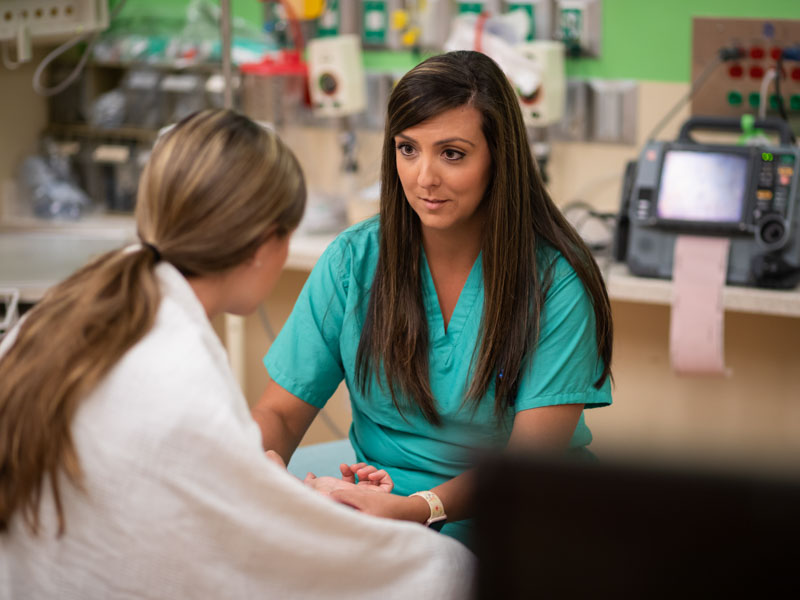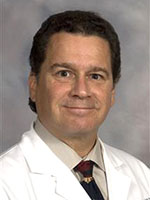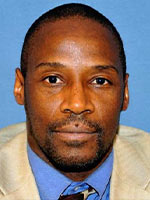New initiative aims to educate providers about human trafficking

A young patient reports to a clinic accompanied by an adult who has no identification but claims to be a relative and insists on answering all of the health care provider’s questions.
A patient who tests positive for a sexually transmitted disease also has injuries in various states of healing in areas of the body that can easily be concealed by clothing.
An unaccompanied patient who can’t provide a home address and doesn’t seem to know what city she is in appears in the Emergency Department and wants to pay her medical bill in cash.
In each of these cases, the patient is reticent or unwilling to provide a credible medical history or divulge any information about how he or she sustained his or her injuries.
Could these individuals be victims of human trafficking? And what can health care providers do to help those who adamantly and repeatedly refuse assistance?
The answers to these questions are what Dr. Robert Galli, professor of emergency medicine, hopes to teach frontline caregivers at the University of Mississippi Medical Center as he spearheads an institution-wide initiative to address the issue of human trafficking.

“When a victim shows up at the ED, the trafficker can’t say exactly what happened,” Galli said, “so he fabricates a story. Many times, the health care provider doesn’t recognize something is amiss.”
Galli has teamed with Valerie Carson, a social worker in University Coordinated Care, to recruit a multidisciplinary committee to explore the subversive problem that is only recently being recognized at health care institutions nationwide.
Carson said awareness is the key to addressing human trafficking.
“We’re trying to put this information in people’s heads so they can recognize it, so the providers can ask the right questions and follow the correct protocols,” she said. “If they recognize it, they can pick up the ball and respond when it’s really needed.”
According to the Federal Bureau of Investigation, human trafficking can be defined as the recruitment, harboring, transportation, provision or obtaining of a person for the purpose of labor or commercial sex in which the labor or commercial sex act is induced by force, fraud or coercion. While many are compelled into labor, Galli said in the United States, the preponderance of trafficking victims are forced into the sex trade.
Although there are a myriad of law enforcement implications to human trafficking, Galli said his focus is on recognizing the victims and providing them with appropriate health care and the means to escape their inhumane situation.
“There’s a $150 billion profit each year from trafficking – the money is why they (traffickers) do it,” Galli said. “This industry didn’t just pop up overnight.
“We’re a hospital. We deal with the medical side of human trafficking. We take care of the (human trafficking) victims. How do we recognize them and how do we extract them (from their environment) and provide appropriate, safe care for them?”
Galli, who established UMMC’s Sexual Assault Nurse Examiner program when he chaired the Department of Emergency Medicine, periodically gives a presentation, “Human Trafficking for the Health Care Professional,” for clinical and other staff throughout the Medical Center who come into direct contact with patients off the street.
He said the first step to addressing human trafficking is to correctly identify the victims.
“In the U.S., 88 percent of human trafficking victims reported having had contact with a health care system – 63 percent with the emergency department,” Galli said. “That’s the most likely place, because as a victim of human trafficking, you’re not going to have a scheduled appointment with a health care provider.
“The Emergency Department is where people can come and go. That’s why I’ve been spreading this information throughout our EDs and walk-in centers.”
Located near the convergence of two major interstate highways and just two states removed from the immigrant crisis at the U.S.-Mexican border, the Medical Center is positioned at the heart of the human trafficking “trade” in the Southeastern United States, according to Walter Henry, a special agent with the Federal Bureau of Investigation. He said UMMC’s location makes it especially important for Medical Center providers to be aware of potential human trafficking victims.

Henry, who presented the UMMC Office of Diversity and Inclusion’s InclUsive Conversation, “Human Trafficking and Medical Needs of Victims,“ at UMMC on April 17, said recognizing victims of human trafficking can be extremely difficult considering they can be of any age or race – or of either sex.
According to the U.S. Department of Justice, an estimated 14,500 to 17,500 women and children are trafficked into the U.S. annually. They migrate for a variety of reasons, from civil unrest or war in their home countries to the false promises of better paying jobs or the ability to pay off debts in America.
Henry said human trafficking victims are sometimes difficult to identify because they often mischaracterize their relationships with the people under whom they are controlled as “normal” relationships. To illustrate, he played an audio clip of a victim who actually defended her “pimp” to law enforcement authorities.
In gentle, subdued tones, the voice of a young girl urged, “This man should not be in jail. He is not a bad person. He saved my life many a time.”
Then came her rationalization: “Either way, I was still going to do it (prostitution). That was just my way of life.”
In another example, Henry said trafficking victims can be brainwashed by their captors, refusing to listen to what the police or health care providers are saying and choosing to believe in the trafficker instead.
“She is relying on the person who’s exploiting her,” he said, “because she doesn’t know if she can trust those who truly want to help her.”
Trafficking victims are vulnerable to coercion and come from all walks of life. More than a third of trafficking is done by an immediate family member, and 27 percent is done by boyfriends. Perhaps the most astonishing fact: the average age of trafficking victims in the U.S. is only 13.
“Pimps can be relatives, and there can be female pimps,” said Henry, who blames popular media for glorifying the pimp subculture, characterizing traffickers as sympathetic, charismatic characters in movies and television.
“It puts them in more of a positive light,” he said. “And there are different types of pimps. The ‘Romeo’ pimp doesn’t put his hands on the victims – they consider themselves too good to do that. The ‘gorilla’ pimp is an abusive pimp.
“The Romeo might bring his girls around the gorilla to show them what their lives might otherwise be like.”
Whatever the scenario, and whomever might be present when a potential victim arrives for treatment, Galli said a multidisciplinary approach is needed to fully address the patient’s needs. He is endeavoring to put together a Human Trafficking Task Force at UMMC to help provide training for caregivers and oversee effective treatment protocols for victims.
“This training will be an ongoing process and will involve a team approach,” Galli said. “Typically the health care providers who attend my lecture – members of the pediatrics faculty, the emergency department faculty, social workers, translation services, the legal department, Campus Police – are eager to help.
“The pediatric group is going to have an entirely different approach than the group from the adult ED, for example. By tapping into each of these groups, we can strengthen the protocols we have in place for these patients.”
Galli said he would like for human trafficking response to become as commonplace in emergency rooms and clinics as other “red flag” protocols.
“A decade ago when a toddler presented with a broken arm or an elderly person was brought to the ED, we didn’t really think anything beyond treatment,” he said. “Now, we start following elder neglect and child abuse protocols.
“When we see a 21-year-old with various injuries, we’re not thinking somebody is trafficking her. The occasional encounter that may be hard to recognize is something every health care worker who sees people who come in off the streets should be aware of. We need to reach out to people and make them aware this is going on and what they can do about it.”
For more information about Galli’s proposed Human Trafficking Coalition or to schedule a human trafficking presentation, email him at rgalli@umc.edu. UMMC caregivers who suspect they may be dealing with a human trafficking victim should contact Campus Police immediately at 4-1360.


